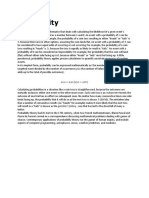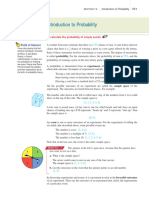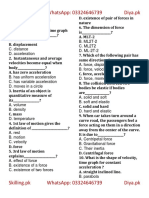0 ratings0% found this document useful (0 votes)
23 viewsGEELECDS Introduction To Probability
This document defines key probability concepts and provides examples of each. It discusses classical, empirical, and subjective probability, as well as concepts like sample space, events, outcomes, equally likely events, complementary events, and using tree diagrams to represent probability spaces. Examples are given for each concept, such as calculating the probability of rolling certain numbers on dice, the likelihood of coin flip outcomes, and subjective probabilities based on a person's experience.
Uploaded by
Ibrahim FerrarizCopyright
© © All Rights Reserved
Available Formats
Download as DOCX, PDF, TXT or read online on Scribd
0 ratings0% found this document useful (0 votes)
23 viewsGEELECDS Introduction To Probability
This document defines key probability concepts and provides examples of each. It discusses classical, empirical, and subjective probability, as well as concepts like sample space, events, outcomes, equally likely events, complementary events, and using tree diagrams to represent probability spaces. Examples are given for each concept, such as calculating the probability of rolling certain numbers on dice, the likelihood of coin flip outcomes, and subjective probabilities based on a person's experience.
Uploaded by
Ibrahim FerrarizCopyright
© © All Rights Reserved
Available Formats
Download as DOCX, PDF, TXT or read online on Scribd
You are on page 1/ 2
1.
Probability – Is a branch of mathematics that deals with the occurrence of a specific event and
predict how possibilities are to happen.
Probability Using a Die
What is the probability of getting a sum of 7 when two dice are thrown?
2. Sample Space – Is a number of possible outcomes that depends on the experiment.
Tossing a coin
Rolling a dice
3. Events – set of outcomes of an experiment
When a number cube is rolled, 1, 2, 3, 4, 5, or 6 is a possible event.
When you roll a number cube and toss a coin at the same time, a possible event is a 3
and a tail respectively.
4. Outcomes – set of results on an experiment
The experiment of coin landing ‘heads’ or ‘tails’.
6 is a possible outcome when a number cube is rolled.
5. Classical Probability – Measures the likelihood (probability) of something happening is a
statistical concept.
Rolling a fair die. It’s equally likely you would get a 1, 2, 3, 4, 5, or 6.
Lottery machines
6. Empirical Probability - The probability of an event based on the outcomes of an experimental
setup repeated numerous times.
Player’s batting average in baseball.
The danger of having a head from a coin toss is ½.
7. Subjective Probability - is a type of probability that is based on an individual's understanding,
knowledge, and experience regarding the possibility of an event.
You think you have an 80% chance of your best friend calling today, because her car
broke down yesterday and she’ll probably need a ride
You think you have a 50/50 chance of getting the job you applied for, because the other
applicant is also very qualified.
8. Equally Likely Events - When the outcomes of an experiment are equally likely to happen
When we toss an unbiased coin, the probability of getting a heads is 1/2 and the
probability of getting a tails is 1/2.
Playing cards
9. Complementary Events - are those two events which are the only possible events
Complementary events with multiple coin flips
Complementary events with a standard 6-sided die
10. Tree Diagrams – To express the probability space
Consider an example in probability to draw a tree diagram for tossing a coin. There are
two branches: head and tail.
The event that ‘the die shows a number greater than 4’ given that ‘there is at least one
tail’.
You might also like
- Handouts ENGINEERING DATA ANALYSIS 2020 CIVIL ENGINEERING PDF100% (3)Handouts ENGINEERING DATA ANALYSIS 2020 CIVIL ENGINEERING PDF15 pages
- The Mechanicals Play Within A Play Edited Script100% (1)The Mechanicals Play Within A Play Edited Script2 pages
- Automatic Street Light Control System Using IOTppt90% (10)Automatic Street Light Control System Using IOTppt21 pages
- Clinical Applications: Syngo Vessel ViewNo ratings yetClinical Applications: Syngo Vessel View8 pages
- Finding The Probability of A Simple Event - Mod 8No ratings yetFinding The Probability of A Simple Event - Mod 831 pages
- Probability: Probability Is A Branch of Mathematics That Deals With Calculating The Likelihood of A Given Event'sNo ratings yetProbability: Probability Is A Branch of Mathematics That Deals With Calculating The Likelihood of A Given Event's4 pages
- Probability (Statistics) : Sama Noor Rimsha Mustafa Eesha Fatima Kainat ShaukatNo ratings yetProbability (Statistics) : Sama Noor Rimsha Mustafa Eesha Fatima Kainat Shaukat13 pages
- Department of Education: Division of Mandaue CityNo ratings yetDepartment of Education: Division of Mandaue City15 pages
- 概率簡介 (Introduction to Probability) - V4 - Final - GNo ratings yet概率簡介 (Introduction to Probability) - V4 - Final - G58 pages
- Probability of Events Education Presentation in Green Cream Blue Nostalgic Handdrawn Style (2)No ratings yetProbability of Events Education Presentation in Green Cream Blue Nostalgic Handdrawn Style (2)31 pages
- Mathematics s4 Sample Offline Learning Basic Probability RLNo ratings yetMathematics s4 Sample Offline Learning Basic Probability RL18 pages
- Probability_Experiments_and_Outcomes_ExpandedNo ratings yetProbability_Experiments_and_Outcomes_Expanded3 pages
- Probability and Probability Distribution - PPTX (Autosaved)No ratings yetProbability and Probability Distribution - PPTX (Autosaved)140 pages
- Probability As A General Concept Can Be Defined As The Chance of An Event OccurNo ratings yetProbability As A General Concept Can Be Defined As The Chance of An Event Occur14 pages
- University of Northeastern Philippines School of Graduate Studies Iriga CityNo ratings yetUniversity of Northeastern Philippines School of Graduate Studies Iriga City4 pages
- Probability and Distribution PPT Rev FinalNo ratings yetProbability and Distribution PPT Rev Final54 pages
- Presented By, Name-Ankita Rath ROLL NO-17STAT008 P.G. Dept. of Statistics 2 YrNo ratings yetPresented By, Name-Ankita Rath ROLL NO-17STAT008 P.G. Dept. of Statistics 2 Yr30 pages
- PROBABILITY AND STATISTICAL ANALYSIS (1)No ratings yetPROBABILITY AND STATISTICAL ANALYSIS (1)29 pages
- 8.1 Experimental Probability & Theoretical ProbabilityNo ratings yet8.1 Experimental Probability & Theoretical Probability19 pages
- Name: Date: Grade & Section: Group #. - ScoreNo ratings yetName: Date: Grade & Section: Group #. - Score2 pages
- Handbook of Hydrophone Element Design TechnologyNo ratings yetHandbook of Hydrophone Element Design Technology2 pages
- Engineers Handbook of Industrial Microwave Heating Industrial Microwave Oven Manufacturers Large Microwaves PDF100% (1)Engineers Handbook of Industrial Microwave Heating Industrial Microwave Oven Manufacturers Large Microwaves PDF9 pages
- MOEP - Public-Private Partnership Development in Thermal Power Generation, Thermal Power Department, Myanmar Electric Power EnterpriseNo ratings yetMOEP - Public-Private Partnership Development in Thermal Power Generation, Thermal Power Department, Myanmar Electric Power Enterprise15 pages
- Pediatrics PreTest Self Assessment and Review Twelfth Edition Robert Yetman - The ebook in PDF format is ready for immediate access100% (1)Pediatrics PreTest Self Assessment and Review Twelfth Edition Robert Yetman - The ebook in PDF format is ready for immediate access50 pages
- Module 1 - Introduction To Numerical Methods PDFNo ratings yetModule 1 - Introduction To Numerical Methods PDF20 pages
- dynamic_correspondence_of_resistance_training_to.7No ratings yetdynamic_correspondence_of_resistance_training_to.79 pages

























































































